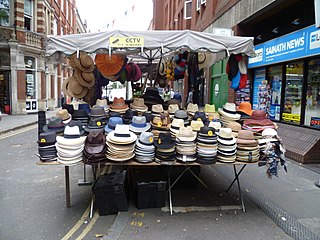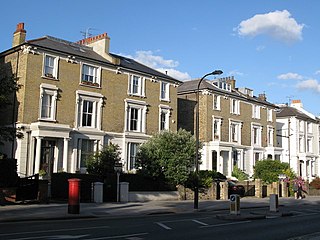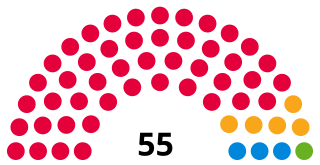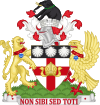
Camden Town, often shortened to Camden, is an area in the London Borough of Camden, around 2.5 miles (4.1 km) north-northwest of Charing Cross. Historically in Middlesex, it is identified in the London Plan as one of 34 major centres in Greater London.

East Street Market also known locally as 'East Street', 'The Lane', or 'East Lane', is a street market in Walworth in South East London.

St Pancras was a civil parish and metropolitan borough in London, England. It was an ancient parish in the county of Middlesex, governed by an administrative vestry. The parish was included in the area of responsibility of the Metropolitan Board of Works in 1855 and became part of the County of London in 1889. The parish of St Pancras became a metropolitan borough in 1900, following the London Government Act 1899, with the parish vestry replaced by a borough council. In 1965 the borough was abolished and its former area became part of the London Borough of Camden in Greater London.

A costermonger, coster, or costard is a street seller of fruit and vegetables in British towns. The term is derived from the words costard and monger (seller), and later came to be used to describe hawkers in general. Some historians have pointed out that a hierarchy existed within the costermonger class and that while costermongers sold from a handcart or animal-drawn cart, mere hawkers carried their wares in a basket.

The Camden markets are a number of adjoining large retail markets, often collectively referred to as Camden Market or Camden Lock, located in the historic former Pickfords stables, in Camden Town, London. It is situated north of the Hampstead Road Lock of the Regent's Canal. Famed for their cosmopolitan image, products sold on the stalls include crafts, clothing, bric-a-brac, and fast food. It is the fourth-most popular visitor attraction in London, attracting approximately 250,000 people each week.

Berwick Street is a street in the Soho district of the City of Westminster, running between Oxford Street to the north and Peter Street at the south. It was built towards the end of the 17th century; several early 18th century buildings have survived. A market was established on the street in the 19th century.

Broadway Market is a street in the London Borough of Hackney, best known for the street market held there. Licences to trade are issued by a committee of councillors from Hackney London Borough Council.

Earlham Street Market is a street market in situated in the Seven Dials area of Covent Garden on a short road between Shaftesbury Avenue and Monmouth Street. Licences to trade are issued by Camden London Borough Council.

Haverstock is an area of the London Borough of Camden: specifically the east of Belsize Park, north of Chalk Farm and west of Kentish Town. It is centred on Queens Crescent and Malden Road. Gospel Oak is to the north, Camden Town to the south.

Queen's Crescent Market is an outdoor street market held every Thursday and Saturday on Queen's Crescent in Kentish Town, Camden between the junction with Malden Road in the West and the junction with Grafton Road in the East. Licences to trade are issued by Camden London Borough Council.

Ridley Road Market but often referred to as "Dalston Market" is the central marketplace in Dalston in the London Borough of Hackney. It is opposite Dalston Kingsland railway station, just off the Kingsland High Street section of the A10, about three miles north of the City of London. It sells a wide range of commodities, including food. Goods, particularly fruit and vegetables, are sold from traditional barrows (trolleys) in the pedestrianised street from 8am to 6pm daily. There is a large range of traditional and exotic produce from around the world. Other stalls and many other shops lining the street sell a wide variety of foods and household goods. New style stalls have recently been introduced by the local council.

The London Borough of Camden is a London borough in Inner London, England. Camden Town Hall, on Euston Road, lies 1.4 mi (2.3 km) north of Charing Cross. The borough was established on 1 April 1965 and includes the former Central London borough of Holborn, and St Pancras and Hampstead.

Camden London Borough Council is the local authority for the London Borough of Camden in Greater London, England. It is a London borough council, one of 32 in the United Kingdom capital of London. Camden is divided into 20 wards, each electing two or three councillors.

Chalton Street Market is a street market in Camden, North London.
Street trading is selling from a stall, stand, or vehicle in the street rather than in a market hall or square. A collection of regular, and adjacent, street traders forms a street market. Where traders operate on their own, from a regular location, these are variously described as isolated pitches, scattered sites, or miscellaneous sites. Peripatetic traders are termed pedlars.

Plender Street Market is an outdoor street market in Camden, North London. Licences to trade are issued by Camden London Borough Council.

Goodge Place Market is an outdoor street market in Fitzrovia, in the London Borough of Camden. Licences to trade are issued by Camden London Borough Council.

Leather Lane Market is an outdoor street market in the Holborn area of the London Borough of Camden. Taking place on Leather Lane, it is the oldest street market in Camden. Licences to trade are issued by Camden London Borough Council.

Swiss Cottage Market is an outdoor street market in Camden, North London. Licences to trade are issued by Camden London Borough Council.























